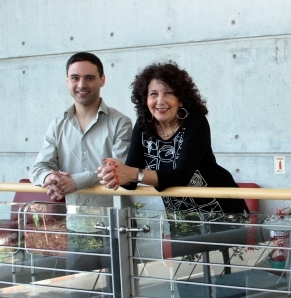One of the most important decisions a cell has to make is whether to live or die. Every single cell in our bodies is armed with genetic “programs” that instruct it to commit suicide when necessary. Cell suicide, however, is not as dire as it sounds: It actually helps prevent cancerous or infected cells from spreading. The self-destruct program also plays an important role in embryonic development: The formation of separate fingers and toes in a developing embryo, for example, relies on the death of cells between the nascent digits.
For quite some time it has been known that the mechanisms of apoptosis and autophagy engage in a complex exchange of information, but scientists have been struggling to identify the proteins that link the two.
Prof. Adi Kimchi and Ph.D. student Assaf Rubinstein of the Weizmann Institute's Molecular Genetics Department reckoned that there might be special “dual-action” proteins that are able to control both processes, thus allowing for direct, efficient communication between the two cell death programs.
What they didn’t expect to discover, however, was that one of these “crosstalk” proteins is actually an essential autophagy protein, called Atg12. In addition to its previously known function in autophagy, the scientists found – through various screening and gene knockdown procedures – that Atg12 also has a drastic effect on the activation of apoptosis. Without Atg12, the apoptotic responses of cells were significantly attenuated. "This was quite surprising as, until now, this protein has only been known to function in autophagy," says Rubinstein. But finding the influential protein was the relatively easy part; the harder task was to understand how Atg12 is able to control apoptosis.
With the help of Miriam Eisenstein of the Chemical Research Support Department, Kimchi and Rubinstein identified a region in the Atg12 protein that is similar to one seen in apoptotic proteins. This region promotes apoptosis by binding to and inhibiting a family of anti-apoptotic proteins called Bcl-2. Could the region on the autophagy protein function in the same way? By employing a special technique to identify protein binding partners, the scientists discovered,
as they reported in
Molecular Cell, that Atg12 is, indeed, able to partner with Bcl-2 and its extended family members, and the end result is apoptosis. They also found that the role Atg12 plays in apoptosis is independent of its role in autophagy: Disrupting its apoptotic function did not impair autophagy and, conversely, disrupting the autophagic pathway did not impair its apoptotic function.
This research may, among other things, have implications for cancer treatment. In many cases, cancer cells shut down the apoptotic process by elevating levels of Bcl-2, in effect enabling the cancer to grow unhindered. Because initial results of the study suggest that Atg12 binds Bcl-2 using a unique mechanism – different from that of other apoptotic proteins – Atg12 might be considered as a possible basis for anti-cancer drugs that target Bcl-2.
The next question the scientists will endeavor to answer is: Why does the cell use the same protein to carry out two different tasks? "We speculate that in certain situations in which a cell is under stress, it first induces autophagy to try and save itself. If this fails, however, it switches to apoptosis to sacrifice itself for the sake of the organism. By employing the same protein, there would be a direct connection between autophagy and apoptosis, making the process much quicker and more efficient," says Rubinstein.
Prof. Adi Kimchi’s research is supported by the Helen and Martin Kimmel Institute for Stem Cell Research. Prof. Kimchi is the incumbent of the Helena Rubinstein Professorial Chair in Cancer Research.
